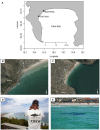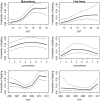The influence of environmental variables on the presence of white sharks, Carcharodon carcharias at two popular Cape Town bathing beaches: a generalized additive mixed model
- PMID: 23874668
- PMCID: PMC3712984
- DOI: 10.1371/journal.pone.0068554
The influence of environmental variables on the presence of white sharks, Carcharodon carcharias at two popular Cape Town bathing beaches: a generalized additive mixed model
Abstract
Shark attacks on humans are high profile events which can significantly influence policies related to the coastal zone. A shark warning system in South Africa, Shark Spotters, recorded 378 white shark (Carcharodon carcharias) sightings at two popular beaches, Fish Hoek and Muizenberg, during 3690 six-hour long spotting shifts, during the months September to May 2006 to 2011. The probabilities of shark sightings were related to environmental variables using Binomial Generalized Additive Mixed Models (GAMMs). Sea surface temperature was significant, with the probability of shark sightings increasing rapidly as SST exceeded 14 °C and approached a maximum at 18 °C, whereafter it remains high. An 8 times (Muizenberg) and 5 times (Fish Hoek) greater likelihood of sighting a shark was predicted at 18 °C than at 14 °C. Lunar phase was also significant with a prediction of 1.5 times (Muizenberg) and 4 times (Fish Hoek) greater likelihood of a shark sighting at new moon than at full moon. At Fish Hoek, the probability of sighting a shark was 1.6 times higher during the afternoon shift compared to the morning shift, but no diel effect was found at Muizenberg. A significant increase in the number of shark sightings was identified over the last three years, highlighting the need for ongoing research into shark attack mitigation. These patterns will be incorporated into shark awareness and bather safety campaigns in Cape Town.
Conflict of interest statement
Figures



References
-
- Simpfendorfer CA, Heupel MR, White WT, Dulvy NK (2011) The importance of research and public opinion to conservation management of sharks and rays: a synthesis. Mar Fresh Res 62: 518–527.
-
- Curtis TH, Bruce BD, Cliff G, Dudley SFJ, Klimley AP, et al... (2012) Responding to the risk of white shark attack: updated statistics, prevention, control methods, and recommendations. In: Global perspectives on the biology and life-history of the white shark. (eds Domeier). CRC Press. 477–510.
-
- Neff C (2012) Australian beach safety and the politics of shark attacks. Coast Manage 40: 88–106.
-
- Baum JK, Myers RA, Kehler DG, Worm B, Harley SJ (2003) Collapse and conservation of shark populations in the Northwest Atlantic. Science 299: 389–392. - PubMed
-
- Myers RA, Baum JK, Shepard TD, Powers SP, Peterson CH (2007) Cascading effects of the loss of apex predatory sharks from a coastal ocean. Science 315: 1846–1850. - PubMed
Publication types
MeSH terms
LinkOut - more resources
Full Text Sources
Other Literature Sources

